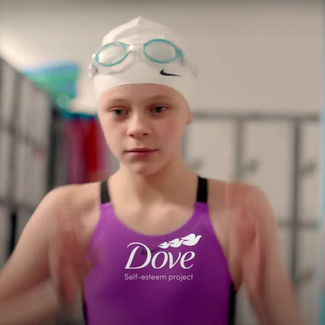
enduring relationships
A thing of real beauty: Ogilvy and Dove
Last night's Super Bowl ad for Dove by Ogilvy was the latest in a partnership that has flourished for over six decades
12 February 2024
Dove's Super Bowl spot that ran last night - its first to run in the game for 18 years - sums up neatly just how far the brand has come in its 67 years with Ogilvy.
The ad features a twist on the Broadway classic, 'It's the Hard Knock Life,' illuminating the pervasive issue of low body confidence among young girls, which stops them from playing the sports they love. It aims to boost self-esteem among young female athletes.
Describing the new ad, Daniel Fisher, global executive creative director at Ogilvy, said: “The emotional trauma young girls can face in a sporting environment, during a time when their body is changing, is sometimes greater than any physical knock they may sustain playing sports. The whacks of a failed landing in gymnastics, nor the hard tackles of soccer are the primary drivers in making girls drop out of sports by age 14, it’s low body confidence.
"We decided to bring this issue to life in the Dove spot using the cultural anthem ‘It’s the Hard Knock Life,’ to drive home our message during the Big Game. An anthem for the resilient spirit, the song perfectly captures the struggle girls go through playing sports while leaving the audience feeling hopeful."
It's all a far cry from Ogilvy's first ad for the Unilever brand which was famously written by David Ogilvy famously himself. The print ad is characteristic of that rather unenlightened and monochrome era, and of the societal norms of the time.
The journey Ogilvy took Dove on from being 'just another' beauty brand to campaigning force only gathered real speed as the world entered the new millennium, and with the launch of a firming lotion (up until 2000 it had primarily been known for its soap bar brand that David Ogilvy would have been familiar with).
It had also traditionally used testimonials in its advertising – a technique that built trust between brand and consumer by facilitating a ‘peer-to-peer’ approach.
2004’s 'Campaign for Real Beauty' famously championed real women for the first time to showcase product efficacy. It's strange now to think how revolutionary this campaign proved to be.
The first stage of the campaign centered on a series of billboard ads, initially put up in Germany and United Kingdom, and later worldwide. The posters showcased photographs of regular women (in place of professional models), taken by Rankin.
The ads invited bypassers to vote on whether a particular model was, for example, "Fat or Fab" or "Wrinkled or Wonderful", with the results of the votes dynamically updated and displayed on the billboard itself. Accompanying the billboard advertisements was the publication of the "Dove Report", a corporate study in which Unilever intended to "[create] a new definition of beauty [which] will free women from self-doubt and encourage them to embrace their real beauty."
This was followed in 2013 by 'Real Beauty Sketches', Ogilvy and Dove's first social experiment ad, which highlighted the extent to which women underestimated their beauty.
The short film featured an FBI-trained sketch artist drawing women first based on their own description of themselves and then on a description from a stranger. The stranger’s descriptions produced a more attractive picture and were more similar to how the woman looked in almost all cases.
The three-minute film did not contain a single mention of Dove products. It became the most viewed viral ad at that time, clocking up 144 million views.
In 2022 Dove launched its 'Toxic Influence' film, which continued its mission to debunk beauty stereotypes and promote self-esteem in women and girls across the world.
It built on 2021's 'Reverse Selfie' work, which again sought to tackle the digital distortion caused by filters and social media.
Both are confrontational campaigns highlighting how far Dove has come from that iconic image of women of all shapes and sizes giggling in their underwear.
The 67-year relationship between Dove and Ogilvy is built on a shared vision to make beauty a source of confidence not anxiety for women and girls everywhere. This vision, and the work behind it, has kept Dove at the forefront of culture, tackling the enemies of self-esteem and building confidence.
What's more it has transformed Dove’s brand value from $1bn at the launch of 'Campaign for Real Beauty' to over $7bn today; turning a humble beauty bar into a superbrand that exists in 76 categories across beauty and personal care building self-esteem and transforming beauty for generations.
The collaboration between Dove and Ogilvy has produced some of the most awarded campaigns of the last decade. It is testament to the nature of the partnership that exists between the two - a partnership that others would probably love the chance to emulate.





